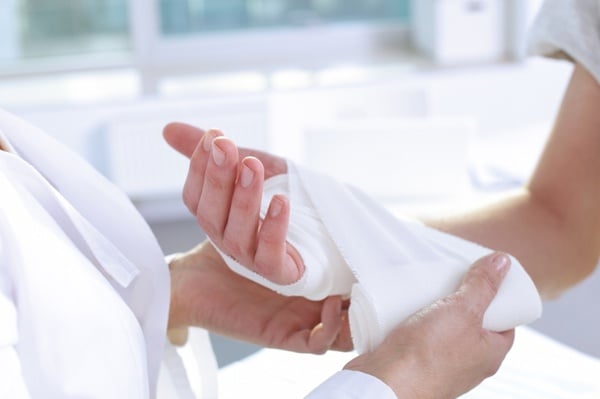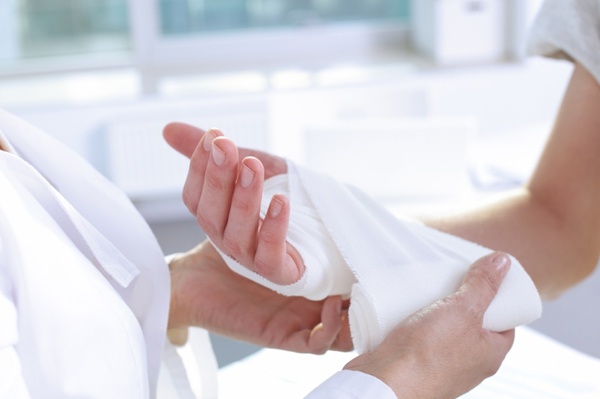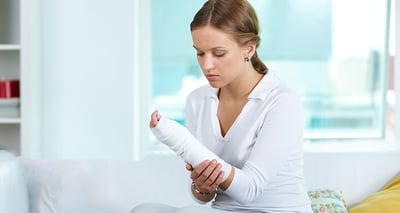The Bone Doctor Guide to Managing Breaks and Fractures


If you have ever suffered from a broken bone, you understand how painful it can be. The treatment and the length of time it takes to heal depends entirely on the bone that is broken and the type of fracture (break) that has taken place.
Broken bones (called fractures) are most common during childhood and as people age. These age groups are at the highest risk for bones to break. Risky behavior and adventurous activities also place individuals at a higher risk for broken bones.
Bones can break - or become fractured after falls, accidents, being struck by something - or they may be pathological. Pathological breaks can be caused by disease or medications and occur without a traumatic incident. To understand the healing time and treatment of broken bones, it is important to understand the types of fractures.
TYPES OF FRACTURES
There are several types of fractures that can occur.

Simple fractures
- Greenstick
- Transverse
- Oblique
- Comminuted
- Impacted
A simple fracture - or closed fracture is a break where bone is broken - but there is no open wound of the skin.
Greenstick. A greenstick fracture is most commonly seen in childhood. Since children's bones are still forming and are not as brittle as an adult's bones, a fractured bone in a child may look like the bone is bent.
Transverse. With a transverse fracture or break - the bone is broken at a right angle.
Oblique. An oblique fracture is a break at an angle to the bone's axis.
Comminuted. When a bone has been broken with fragments or several pieces, it is referred to as a comminuted fracture.
An impacted fracture. An impacted fracture occurs when one end of the bone is driven into the other. It is most commonly seen in children - and may also be called a buckle fracture.
Compound fracture. A compound fracture may also be called an open fracture. This is a break where the bone sticks through the skin.
Complete and Incomplete fractures. When a bone has been broken to the point that the pieces are completely separated from each other, it is called a complete fracture. With an incomplete fracture or break, the bone is cracked or only partially broken through.
SYMPTOMS OF A BROKEN BONE
You may think that someone would always be aware that they have a broken bone. This is not always the case. There are symptoms though, and a bone doctor should be consulted if you or someone you are with have the symptoms of a broken bone.
- Pain

- Loss of functionality
- Significant bruising
- Physical deformity
- Swelling
- Tenderness
- Unable to bear weight (legs)
It is a fairly common occurrence that greenstick fractures in children may go undetected and treated as a minor incident. It is important for any type of break to be treated properly by your healthcare professional - preferably a bone doctor.
TREATMENT OF FRACTURES
The route of treatment will depend on the type and severity of the break. Initially, x-rays will be taken in order to identify the correct treatment plan.
- Reduction
- Surgery
- Devices
- Therapies
Reduction. Reduction of the break refers to putting it back into its correct position. If the break is closed, and not severe - it can be done manually, without a procedure.
Surgery. If the break is severe, chances are your bone doctor will need to reduce the fracture during surgery. An implant or metal screws or plates may need to be placed to hold the bone pieces together to enable proper healing.
Devices. There are several devices used to assist a broken bone to heal. Elastic bandages, splints, plaster or air casts and traction splints. These are all devices used to stabilize the break and hold the bone in place.
Therapies. Again, depending on the type and severity of the break - physical therapy may be needed following the bone's healing. After a bone is immobile for a length of time, becoming mobile may need therapeutic exercises and strengthening to get it functioning properly once again.
What to do in an Emergency
Accidents happen - and preparing ahead for emergencies is always a good idea. In the case of a broken bone during a sporting activity, accident or trauma - it is important to know the basic first aid to provide until you can get to a bone doctor.
- Stop bleeding. If there is bleeding, apply pressure and elevate.
- Immobilize the area. When there is a suspected fracture, immobilize the area and keep the person as still as possible. Use a splint or sling if one is available.
- Ice the area. Use an ice pack or cubes wrapped in cloth to the area for ten minutes at a time.
- Help the person get comfortable without disturbing the affected area. Cover them with a blanket and encourage rest until professional help can be obtained.
The main take-away when it comes to any type of bone fracture is to let a bone doctor properly diagnose and treat the problem as soon as possible. A fracture that heals improperly can be the source of many health issues in the future.
Contact us to schedule a consultation with an orthopedic specialist today!


